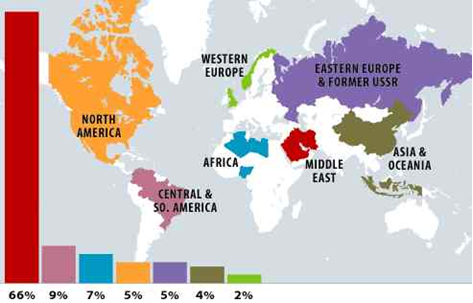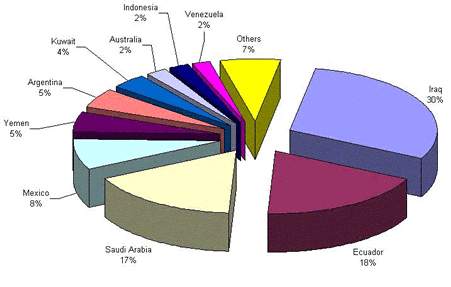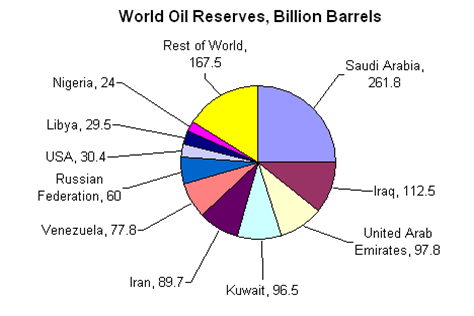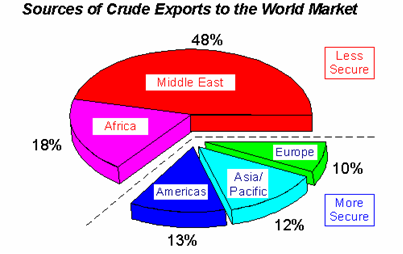

 |
 |
 |
 |
 |
 |
| 中文 |
| اللغة العربية |
Petroleum |
Petroleum (from Greek petra – rock and elaion – oil or Latin oleum – oil) or crude oil, sometimes colloquially called black gold or "Texas Tea", is a thick, dark brown or greenish liquid. Petroleum exists in the upper strata of some areas of the Earth's crust. It consists of a complex mixture of various hydrocarbons, largely of the alkane series, but may vary much in appearance and composition. Petroleum is used mostly, by volume, for producing fuel oil and gasoline (or petrol), both important "primary energy" sources (IEA Key World Energy Statistics). Petroleum is also the raw material for many chemical products, including solvents, fertilizers, pesticides, and plastics.

Formation
Most geologists view crude oil, like coal and natural gas, as the product of compression and heating of ancient vegetation over geological time scales. According to this theory, it is formed from the decayed remains of prehistoric marine animals and terrestrial plants. Over many centuries this organic matter, mixed with mud, is buried under thick sedimentary layers of material. The resulting high levels of heat and pressure cause the remains to metamorphose, first into a waxy material known as kerogen, and then into liquid and gaseous hydrocarbons in a process known as catagenesis. These then migrate through adjacent rock layers until they become trapped underground in porous rocks called reservoirs, forming an oil field, from which the liquid can be extracted by drilling and pumping. 150 m is generally considered the "oil window". Though this corresponds to different depths for different locations around the world, a 'typical' depth for an oil window might be 4 - 5 km. Three conditions must be present for oil reservoirs to form: a rich source rock, a migration conduit, and a trap (seal) that forms the reservoir.
The reactions that produce oil and natural gas are often modeled as first order breakdown reactions, where kerogen breaks down to oil and natural gas by a large set of parallel reactions, and oil eventually breaks down to natural gas by another set of reactions.
Abiogenic theory
The idea of abiogenic petroleum origin was championed in the Western world by Thomas Gold based on thoughts from Russia, mainly on studies of Nikolai Kudryavtsev. The idea proposes that large amounts of carbon exist naturally in the planet, some in the form of hydrocarbons. Hydrocarbons are less dense than aqueous pore fluids, and migrate upward through deep fracture networks. Thermophilic, rock-dwelling microbial life-forms are in part responsible for the biomarkers found in petroleum.
This theory is very much a minority opinion amongst geologists. This theory often pops up when scientists are not able to explain apparent oil inflows into certain oil reservoirs. These instances are rare.

Extraction
Locating an oil field is the first obstacle to be overcome.
Today, petroleum engineers use instruments such as gravimeters and magnetometers
in the search for petroleum. Generally, the first stage in the extraction
of crude oil is to drill a well into the underground reservoir. Historically,
in the USA, some oil fields existed where the oil rose naturally to the
surface, but most of these fields have long since been depleted, except
for certain remote locations in Alaska. Often many wells (called multilateral
wells) are drilled into the same reservoir, to ensure that the extraction
rate will be economically viable. Also, some wells (secondary wells) may
be used to pump water, steam, acids or various gas mixtures into the reservoir
to raise or maintain the reservoir pressure, and so maintain an economic
extraction rate.
If the underground pressure in the oil reservoir is sufficient, then the
oil will be forced to the surface under this pressure. Gaseous fuels or
natural gas are usually present, which also supply needed underground
pressure. In this situation it is sufficient to place a complex arrangement
of valves (the Christmas tree) on the well head to connect the well to
a pipeline network for storage and processing. This is called primary
oil recovery. Usually, only about 20% of the oil in a reservoir can be
extracted this way.
Over the lifetime of the well the pressure will fall, and at some point
there will be insufficient underground pressure to force the oil to the
surface. If economical, and it often is, the remaining oil in the well
is extracted using secondary oil recovery methods (see: energy balance
and net energy gain). Secondary oil recovery uses various techniques to
aid in recovering oil from depleted or low-pressure reservoirs. Sometimes
pumps, such as beam pumps and electrical submersible pumps (ESPs), are
used to bring the oil to the surface. Other secondary recovery techniques
increase the reservoir's pressure by water injection, natural gas reinjection
and gas lift, which inject air, carbon dioxide or some other gas into
the reservoir. Together, primary and secondary recovery allows 25% to
35% of the reservoir's oil to be recovered.
Tertiary oil recovery reduces the oil's viscosity to increase oil production.
Tertiary recovery is started when secondary oil recovery techniques are
no longer enough to sustain production, but only when the oil can still
be extracted profitably. This depends on the cost of the extraction method
and the current price of crude oil. When prices are high, previously unprofitable
wells are brought back into production and when they are low, production
is curtailed. Thermally enhanced oil recovery methods (TEOR) are tertiary
recovery techniques that heat the oil and make it easier to extract.
Steam injection is the most common form of TEOR, and is often done with
a cogeneration plant. In this type of cogeneration plant, a gas turbine
is used to generate electricity and the waste heat is used to produce
steam, which is then injected into the reservoir. This form of recovery
is used extensively to increase oil production in the San Joaquin Valley,
which has very heavy oil, yet accounts for 10% of the United States' oil
production. In-situ burning is another form of TEOR, but instead of steam,
some of the oil is burned to heat the surrounding oil. Occasionally, detergents
are also used to decrease oil viscosity. Tertiary recovery allows another
5% to 15% of the reservoir's oil to be recovered.

Alternative Means of Producing Oil
As oil prices continue to escalate, other alternatives
to producing oil have been gaining importance. The most viable of these
is the coal to oil process, of which the most efficient is the Karrick
process, which converts coal into crude oil. Production has been estimated
to be work out at about $35 per barrel.
A less efficient methodology is the Fischer-Tropsch process. It was a
concept pioneered in Nazi Germany when imports of petroleum were restricted
due to war and Germany found a method to extract oil from coal. It was
known as Ersatz ("substitute" in German), and accounted for
nearly half the total oil used in WWII by Germany. However, the process
was used only as a last resort as naturally occurring oil was much cheaper.
As crude oil prices increase, the cost of coal to oil conversion becomes
comparatively cheaper.
The method involves converting high ash coal into synthetic oil in a multistage
process. Ideally, a ton of coal produces nearly 200 liters (1.25 bbl,
52 US gallons) of crude, with by-products ranging from tar to rare chemicals.
Currently, two companies have commercialized their Fischer-Tropsch technology.
Shell in Bintulu, Malaysia, uses natural gas as a feedstock, and produces
primarily low-sulfur diesel fuels. Sasol in South Africa uses coal as
a feedstock, and produces a variety of synthetic petroleum products. The
process is today used in South Africa to produce most of the country's
diesel fuel from coal by the company Sasol. The process was used in South
Africa to meet its energy needs during its isolation under Apartheid.
This process has received renewed attention in the quest to produce low
sulfur diesel fuel in order to minimize the environmental impact from
the use of diesel engines.
More recently explored is Thermal depolymerization (TDP). In theory, TDP
can convert any organic waste into petroleum.
History
The first oil wells were drilled in China in the 4th century
or earlier. They had depth of up to 243 meters and were drilled using
bits attached to bamboo poles. The oil was burned to evaporate brine and
produce salt. By the 10th century, extensive bamboo pipelines connected
oil wells with salt springs. Ancient Persian tablets indicate the medicinal
and lighting uses of petroleum in the upper echelons of their society.
In the 8th century, the streets of the newly-constructed Baghdad were
paved with tar, derived from easily-accessible petroleum from natural
fields in the region. In the 9th century, oil fields were exploited in
Baku, Azerbaijan, to produce naphtha. These fields were described by the
geographer Masudi in the 10th century, and by Marco Polo in the 13th century,
who described the output of those wells as hundreds of shiploads.
The modern history of petroleum began in 1846, with the discovery of the
process of refining kerosene from coal by Atlantic Canada's Abraham Pineo
Gesner. Poland's Ignacy Łukasiewicz discovered a means of refining kerosene
from the more readily available "rock oil" ("petr-oleum")
in 1852 and the first rock oil mine was built in Bobrka, near Krosno in
southern Poland in the following year. These discoveries rapidly spread
around the world, and Meerzoeff built the first Russian refinery in the
mature oil fields at Baku in 1861. At that time Baku produced about 90%
of the world's oil. The battle of Stalingrad was fought over Baku (now
the capital of the Azerbaijan Republic).
The first commercial oil well drilled in North America was in Oil Springs,
Ontario, Canada in 1858, dug by James Miller Williams. The American petroleum
industry began with Edwin Drake's discovery of oil in 1859, near Titusville,
Pennsylvania. The industry grew slowly in the 1800s, driven by the demand
for kerosene and oil lamps. It became a major national concern in the
early part of the 20th century; the introduction of the internal combustion
engine provided a demand that has largely sustained the industry to this
day. Early "local" finds like those in Pennsylvania and Ontario
were quickly exhausted, leading to "oil booms" in Texas, Oklahoma,
and California.
By 1910, significant oil fields had been discovered in Canada (specifically,
in the province of Alberta), the Dutch East Indies (1885, in Sumatra),
Persia (1908, in Masjed Soleiman), Peru, Venezuela, and Mexico, and were
being developed at an industrial level.
Even until the mid-(1950s), coal was still the world's foremost fuel,
but oil quickly took over. Following the 1973 energy crisis and the 1979
energy crisis, there was significant media coverage of oil supply levels.
This brought to light the concern that oil is a limited resource that
will eventually run out, at least as an economically viable energy source.
At the time, the most common and popular predictions were always quite
dire, and when they did not come true, many dismissed all such discussion.
The future of petroleum as a fuel remains somewhat controversial. USA
Today news (2004) reports that there are 40 years of petroleum left in
the ground. Some would argue that because the total amount of petroleum
is finite, the dire predictions of the 1970s have merely been postponed.
Others argue that technology will continue to allow for the production
of cheap hydrocarbons and that the earth has vast sources of unconventional
petroleum reserves in the form of tar sands, bitumen fields and oil shale
that will allow for petroleum use to continue in the future, with both
the Canadian tar sands and United States shale oil deposits representing
potential reserves matching existing liquid petroleum deposits worldwide.
Today, about 90% of vehicular fuel needs are met by oil. Petroleum also
makes up 40% of total energy consumption in the United States, but is
responsible for only 2% of electricity generation. Petroleum's worth as
a portable, dense energy source powering the vast majority of vehicles
and as the base of many industrial chemicals makes it one of the world's
most important commodities. Access to it was a major factor in several
military conflicts, including World War II and the Persian Gulf War. About
80% of the world's readily accessible reserves are located in the Middle
East, with 62.5% coming from the Arab 5: Saudi Arabia (12.5%), UAE, Iraq,
Qatar and Kuwait. The USA has less than 3%.
Environmental Effects
The presence of oil has significant social and environmental
impacts, from accidents and routine activities such as seismic exploration,
drilling, and generation of polluting wastes. Oil extraction is costly
and sometimes environmentally damaging, although Dr. John Hunt from Woods
Hole pointed out in a 1981 paper that over 70% of the reserves in the
world are associated with visible macro-seepages, and many oil fields
are found due to natural leaks. Offshore exploration and extraction of
oil disturbs the surrounding marine environment. Extraction may involve
dredging, which stirs up the seabed, killing the sea plants that marine
creatures need to survive. Crude oil and refined fuel spills from tanker
ship accidents have damaged fragile ecosystems in Alaska, the Galapagos
Islands, Spain, and many other places.
Burning oil releases carbon dioxide into the atmosphere, which contributes
to global warming. Per energy unit, oil produces less CO2 than coal, but
more than natural gas. However, oil's unique role as a transportation
fuel makes reducing its CO2 emissions a particularly thorny problem; amelioration
strategies such as carbon sequestering are generally geared for large
power plants, not individual vehicles.
Renewable energy source alternatives do exist, although the degree to
which they can replace petroleum and the possible environmental damage
they may cause are uncertain and controversial. Sun, wind, geothermal,
and other renewable electricity sources cannot directly replace high energy
density liquid petroleum for transportation use; instead automobiles and
other equipment must be altered to allow using electricity (in batteries)
or hydrogen (via fuel cells or internal combustion) which can be produced
from renewable sources. Other options include using biomass-origin liquid
fuels (ethanol, biodiesel). Any combination of solutions to replace petroleum
as a liquid transportation fuel will be a very large undertaking.

Classification
The oil industry classifies "crude" by the location
of its origin (e.g., "West Texas Intermediate, WTI" or "Brent")
and often by its relative weight (API gravity) or viscosity ("light",
"intermediate" or "heavy"); refiners may also refer
to it as "sweet", which means it contains relatively little
sulfur, or as "sour", which means it contains substantial amounts
of sulfur and requires more refining in order to meet current product
specifications.
The world reference barrels are:
- Brent Blend, comprising 15 oils from fields in the Brent and Ninian systems in the East Shetland Basin of the North Sea. The oil is landed at Sullom Voe terminal in the Shetlands. Oil production from Europe, Africa and Middle Eastern oil flowing West tends to be priced off the price of this oil, which forms a benchmark. See also Brent crude.
- West Texas Intermediate (WTI) for North American oil.
- Dubai, used as benchmark for Middle East oil flowing to the Asia-Pacific region.
- Tapis (from Malaysia, used as a reference for light Far East oil)
- Minas (from Indonesia, used as a reference for heavy Far East oil)
- The OPEC basket used to be the average price of the following blends:
a. Arab Light Saudi Arabia
b. Bonny Light Nigeria
c. Fateh Dubai
d. Isthmus Mexico (non-OPEC)
e. Minas Indonesia
f. Saharan Blend Algeria
g. Tia Juana Light Venezuela
In June 15, 2005 the OPEC basket was changed to reflect the characteristics of the oil produced by OPEC members. The new OPEC Reference Basket (ORB) is made up of the following: Saharan Blend (Algeria), Minas (Indonesia), Iran Heavy (Islamic Republic of Iran), Basra Light (Iraq), Kuwait Export (Kuwait), Es Sider (Libya), Bonny Light (Nigeria), Qatar Marine (Qatar), Arab Light (Saudi Arabia), Murban (UAE) and BCF 17 (Venezuela).
Uses:
The chemical structure of petroleum is composed of hydrocarbon chains
of different lengths. Because of this, petroleum may be taken to oil refineries
and the hydrocarbon chemicals separated by distillation and treated by
other chemical processes, to be used for a variety of purposes. See Petroleum
products.
- Ethane and other short-chain alkanes which are used as fuel
- Diesel fuel (petro-diesel)
- Fuel oils
- Gasoline
- Jet fuel
- Kerosene
- Liquid petroleum gas (LPG)
- Natural gas
Generally used in transportation, power
plants and heating.
Petroleum vehicles are internal combustion engine vehicles.
Other derivatives:
Certain types of resultant hydrocarbons may be mixed with other non-hydrocarbons,
to create other end products:
- Alkenes (olefins) which can be manufactured into plastics or other compounds
- Lubricants (produces light machine oils, motor oils, and greases, adding viscosity stabilizers as required).
- Wax, used in the packaging of frozen foods, among others.
- Sulfur or Sulfuric acid. These are a useful industrial materials. Sulfuric acid is usually prepared as the acid precursor oleum, a by-product of sulfur removal from fuels.
- Bulk tar.
- Asphalt
- Petroleum coke, used in specialty carbon products or as solid fuel.
- Paraffin wax
- Aromatic petrochemicals to be used as precursors in other chemical production.
References to the oil prices are usually either references to the spot price of either WTI/Light Crude as traded on New York Mercantile Exchange (NYMEX) for delivery in Cushing, Oklahoma; or the price of Brent as traded on the International Commodities Exchange (ICE, which the International Petroleum Exchange has been incorporated into) for delivery at Sullom Voe. The price of a barrel of oil is highly dependent on both its grade (which is determined by factors such as its specific gravity or API and its Sulphur content) and location. The vast majority of oil will not be traded on an exchange but on a over-the-counter basis, typically with reference to a marker crude oil grade that is typically quoted via pricing agencies such as Argus Media Ltd and Platts. For example in Europe a particular grade of oil, say Fulmar, might be sold at a price of "Brent plus US$0.25/barrel" or as an intra-company transaction. IPE claim that 65% of traded oil is priced off their Brent benchmarks. Other important benchmarks include Dubai, Tapis, and the OPEC basket. The Energy Information Administration (EIA) uses the Imported Refiner Acquisition Cost, the weighted average cost of all oil imported into the US as their "world oil price".
It is often claimed that OPEC sets the oil price and the true cost of a barrel of oil is around $2, which is equivalent to the cost of extraction of a barrel in the Middle East. These estimates of costs ignore the cost of finding and developing oil reserves. Furthermore the important cost as far as price is concerned, is not the price of the cheapest barrel but the cost of producing the marginal barrel. By limiting production OPEC has caused more expensive areas of production such as the North Sea to be developed before the Middle East has been exhausted. OPEC's power is also often overstated. Investing in spare capacity is expensive and the low oil price environment in the late 90s led to cutbacks in investment. This has meant during oil price rallies, OPEC's spare capacity has not been sufficient to stabilize prices.
Oil demand is highly dependent on global macroeconomic conditions, so this is also an important determinant of price. Some economists claim that high oil prices have a large negative impact on the global growth. This means that the relationship between the oil price and global growth is not particularly stable although a high oil price is often thought of as being a late cycle phenomenon.
The most recent low point was reached in January 1999, after increased oil production from Iraq coincided with the Asian financial crisis, which reduced demand. The prices then rapidly increased, more than doubling by September 2000, then fell until the end of 2001 before steadily increasing, reaching US $40 to US $50 per barrel by September 2004. In October 2004, light crude futures contracts on the NYMEX for November delivery exceeded US $53 per barrel and for December delivery exceeded US $55 per barrel. Crude oil prices surged to record highs above $85 a barrel in October 2007, sustaining a rally built on strong demand for gasoline and diesel and on concerns about refiners' ability to keep up.
The New York Mercantile Exchange (NYMEX) trades crude oil (including futures contracts) and provides the basis of US crude oil pricing via WTI (West Texas Intermediate). Other exchanges also trade crude oil futures, e.g. the International Commodities Exchange (ICE) in London trades contracts in Brent crude. Even individuals can now trade crude oil through online trading sites margin account or their banks through structured products indexed on the Commodities markets.
Top Petroleum-Producing Countries
| In order of amount produced in 2007 | (MMbbl/d = millions of barrels per day) | In order of amount exported in 2007 |
| Saudi Arabia (OPEC) | 10.37 MMbbl/d | Saudi Arabia (OPEC) |
| Russia | 09.27 MMbbl/d | Russia |
| United States | 18.69 MMbbl/d | Norway |
| Iran (OPEC) | 04.09 MMbbl/d | Iran (OPEC) |
| Mexico | 13.83 MMbbl/d | United Arab Emirates (OPEC) |
| China | 13.62 MMbbl/d | Venezuela (OPEC) |
| Norway | 13.18 MMbbl/d | Kuwait (OPEC) |
| Canada | 13.14 MMbbl/d | Nigeria (OPEC) |
| Venezuela (OPEC) | 12.86 MMbbl/d | Mexico |
| United Arab Emirates (OPEC) | 02.76 MMbbl/d | Algeria (OPEC) |
| Kuwait (OPEC) | 02.51 MMbbl/d | Libya (OPEC) |
| Nigeria (OPEC) | 02.51 MMbbl/d | |
| United Kingdom | 12.08 MMbbl/d | |
| Iraq (OPEC) | 22.03 MMbbl/d | |
| *Peak production already passed in this state. | *Though still a member, Iraq has not been included in production figures since 1998. | * Note that the USA consumes almost
all of its own production, whilst the UK has recently become a net-importer
rather than net-exporter. * Total world production/consumption (as of 2006) is approximately 84 million barrels per day. |
Typical Light,
Sweet Crude Oil Contract Specification
Futures: 1,000 U.S. barrels (42,000 gallons).
Options: One NYMEX Division light, sweet crude oil futures contract.
Price Quotation
Futures and Options: Dollars and cents per barrel.
Trading Hours
Futures and Options: Open outcry trading is conducted from 10:00 A.M.
till 2:30 P.M.
After hours futures trading are conducted via the NYMEX ACCESS® internet-based
trading platform beginning at 3:15 P.M. on Mondays through Thursdays and
concluding at 9:30 A.M. the following day. On Sundays, the session begins
at 7:00 P.M. All times is New York time.
Trading Months
Futures: 30 consecutive months plus long-dated futures initially listed
36, 48, 60, 72, and 84 months prior to delivery.
Additionally, trading can be executed at an average differential to the
previous day's settlement prices for periods of two to 30 consecutive
months in a single transaction. These calendar strips are executed during
open outcry trading hours.
Options: 12 consecutive months, plus three long-dated options at 18, 24,
and 36 months out on a June/December cycle.
Minimum Price Fluctuation
Futures and Options: $0.01 (1¢) per barrel ($10.00 per contract).
Maximum Daily Price Fluctuation
Futures: $10.00 per barrel ($10,000 per contract) for all months. If any
contract is traded, bid, or offered at the limit for five minutes, trading
is halted for five minutes. When trading resumes, the limit is expanded
by $10.00 per barrel in either direction. If another halt were triggered,
the market would continue to be expanded by $10.00 per barrel in either
direction after each successive five-minute trading halt. There will be
no maximum price fluctuation limits during any one trading session.
Options: No price limits.
Last Trading Day
Futures: Trading terminates at the close of business on the third business
day prior to the 25th calendar day of the month preceding the delivery
month. If the 25th calendar day of the month is a non-business day, trading
shall cease on the third business day prior to the last business day preceding
the 25th calendar day.
Options: Trading ends three business days before the underlying futures
contract.
Exercise of Options
By a clearing member to the Exchange clearinghouse not later than 5:30
P.M., or 45 minutes after the underlying futures settlement price is posted,
whichever is later, on any day up to and including the option's expiration.
Options Strike Prices
Twenty strike prices in increments of $0.50 (50¢) per barrel above and
below the at-the-money strike price, and the next ten strike prices in
increments of $2.50 above the highest and below the lowest existing strike
prices for a total of at least 61 strike prices. The at-the-money strike
price is nearest to the previous day's close of the underlying futures
contract. Strike price boundaries are adjusted according to the futures
price movements.
Delivery
F.O.B. seller's facility, Cushing, Oklahoma, at any pipeline or storage
facility with pipeline access to TEPPCO, Cushing storage, or Equilon Pipeline
Co., by in-tank transfer, in-line transfer, book-out, or inter-facility
transfer (pumpover).
Delivery Period
All deliveries are rateable over the course of the month and must be initiated
on or after the first calendar day and completed by the last calendar
day of the delivery month.
Alternate Delivery Procedure
(ADP)
An alternate delivery procedure is available to buyers and sellers who
have been matched by the Exchange subsequent to the termination of trading
in the spot month contract. If buyer and seller agree to consummate delivery
under terms different from those prescribed in the contract specifications,
they may proceed on that basis after submitting a notice of their intention
to the Exchange.
Exchange of Futures for,
or in Connection with, Physicals (EFP)
The commercial buyer or seller may exchange a futures position for a physical
position of equal quantity by submitting a notice to the Exchange. EFPs
may be used to either initiate or liquidate a futures position.
Deliverable Grades
Specific domestic crudes with 0.42% sulfur by weight or less, not less
than 37° API gravity or more than 42° API gravity. The following domestic
crude streams are deliverable: West Texas Intermediate, Low Sweet Mix,
New Mexican Sweet, North Texas Sweet, Oklahoma Sweet, South Texas Sweet.
Specific foreign crude of not less than 34° API nor more than 42° API.
The following foreign streams are deliverable: U.K. Brent and Forties,
and Norwegian Oseberg Blend, for which the seller shall receive a 30¢-per-barrel
discount below the final settlement price; Nigerian Bonny Light and Colombian
Cusiana are delivered at 15¢ premiums; and Nigerian Qua Iboe is delivered
at a 5¢ premium.
Inspection
Inspection shall be conducted in accordance with pipeline practices. A
buyer or seller may appoint an inspector to inspect the quality of oil
delivered. However, the buyer or seller who requests the inspection will
bear its costs and will notify the other party of the transaction that
the inspection will occur.
Position Accountability
Limits
Any one month/all months: 20,000 net futures, but not to exceed 1,000
in the last three days of trading in the spot month.
Margin Requirements
Margins are required for open futures or short options positions. The
margin requirement for an options purchaser will never exceed the premium.
Trading Symbols
Futures: CL
Options: LO
Futures and Options Trading involve risk of loss and is not suitable for everyone. Options, cash & futures markets are separate and distinct and do not necessarily respond in the same way to similar market stimulus. A movement in the cash market would not necessarily move in tandem with the related futures & options contract being offered.
Copyright © 2007 - 2022
ARABCCI, All rights reserved | جميع الحقوق محفوظة | 不得轉載 | Disclaimer | Site Map